Camille Sebastien Nachet.
1799 - 1881.
by Roland Mortimer, Brazil
Microscopy is something we all have in common
and enjoy. So much has been written about what we can see, so
let's turn our minds to the one thing we all take for granted,
our instruments, for without them the pleasure would be
absolutely lost. The range and great diversity of instruments we
all have is amazing to say the least. I'd like to show you a few
of the microscopes I have by a probably not so well known
manufacturer who began making his microscopes in a small workshop
based at ; 16, rue Serpente, Paris in 1839.

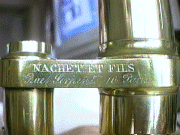 The first is a small, all brass model he calls his
modéle pétit, which means small model, probably sold as a
student model or even as an expensive toy. The main tube is
pushed/pulled up/down for coarse focus and fine focus is achieved
by the knurled micrometer screw at the lower rear of the pillar.
The 'button' objective is simply a single lens, which gives a
maximum power of 250 diameters with the No. 2 eye-piece. There is
a perforated brass wheel below the stage with various sizes of
hole acting as a simple form of iris. This instrument dates from
between 1856 - 1862.
The first is a small, all brass model he calls his
modéle pétit, which means small model, probably sold as a
student model or even as an expensive toy. The main tube is
pushed/pulled up/down for coarse focus and fine focus is achieved
by the knurled micrometer screw at the lower rear of the pillar.
The 'button' objective is simply a single lens, which gives a
maximum power of 250 diameters with the No. 2 eye-piece. There is
a perforated brass wheel below the stage with various sizes of
hole acting as a simple form of iris. This instrument dates from
between 1856 - 1862.
Nachet moved his business to 17, rue St.
Séverin, Paris in 1862. In 1851 Nachet was awarded a gold medal
at the Great Exhibition for the quality of the workmanship of his
instruments. Among his numerous inventions he is credited with
splitting the rays in a binocular microsocope so as to produce a
stereoscopic image.
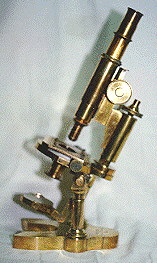 The second instrument is a little more complicated.
Nachet calls this his No.2 Grand model. As you can see it's all
brass, mounted on Roman pillar-like trunnions. Coarse focus is
obtained via rack and pinion (the teeth are almost horizontal) by
turning the single knurled knob. Fine focus is obtained via the
knurled knob situated at the top of the pillar which supports the
tube. This is a single spring system, the spring is compressed as
the screw is turned clock-wise thus forcing the pillar to move
slowly down the brass prismatic column inside the pillar, when
the screw is released the spring forces the pillar in an upward
direction.
The second instrument is a little more complicated.
Nachet calls this his No.2 Grand model. As you can see it's all
brass, mounted on Roman pillar-like trunnions. Coarse focus is
obtained via rack and pinion (the teeth are almost horizontal) by
turning the single knurled knob. Fine focus is obtained via the
knurled knob situated at the top of the pillar which supports the
tube. This is a single spring system, the spring is compressed as
the screw is turned clock-wise thus forcing the pillar to move
slowly down the brass prismatic column inside the pillar, when
the screw is released the spring forces the pillar in an upward
direction.
The stage has a simple X/Y mechanical stage
operated by the two wheels mounted on either side of the stage.
There is an ungraduated draw- tube to adjust tube length. The
mirror is attached to a gimble which allows the same to be placed
in almost any position for various illumination effects. The
condenser is simply a lens in carrier which is a push fit into
the condenser tube. The microscope dates from ca. 1875. The
address inscribed on the rear of the base is; Nachet, 17, Rue St.
Séverin, Paris.
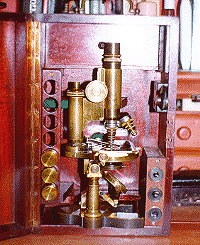 The third instrument is what Nachet calls his Large
Perfected Model and probably dates from around 1880. This
instrument is very similar to the Grand model with the following
differences; the mechanical stage has a round, black, glass plate
surrounding the aperture in the stage. The front edge of the
stage is graduated and in the centre of the stage base there is a
graduated rule. The condenser is simple but much improved from
the former models, and there is also an iris diaphragm which
swings in/out of centre. The whole is placed on a small dovetail
piece, and is raised/lowered by a unique lever system. The double
mirror can be removed and replaced by unscrewing the brass cover
ring and is mounted on an articulated gimble to give the various
illumination effects. I believe this model to be from around 1880
because it does not have the "modern" innovations of
the 1890 model, i.e. graduated main tube, improved condenser/iris
with stops and adjusting coaxial screw system.
The third instrument is what Nachet calls his Large
Perfected Model and probably dates from around 1880. This
instrument is very similar to the Grand model with the following
differences; the mechanical stage has a round, black, glass plate
surrounding the aperture in the stage. The front edge of the
stage is graduated and in the centre of the stage base there is a
graduated rule. The condenser is simple but much improved from
the former models, and there is also an iris diaphragm which
swings in/out of centre. The whole is placed on a small dovetail
piece, and is raised/lowered by a unique lever system. The double
mirror can be removed and replaced by unscrewing the brass cover
ring and is mounted on an articulated gimble to give the various
illumination effects. I believe this model to be from around 1880
because it does not have the "modern" innovations of
the 1890 model, i.e. graduated main tube, improved condenser/iris
with stops and adjusting coaxial screw system.
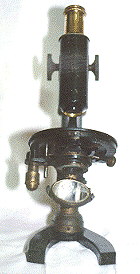
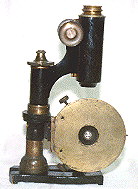 The fourth and last microsocpe I have by Nachet is a
small folding model from ca. 1910. This model is all brass, but
is lacquered black according to the style of the period. The arms
of the base are in the form of elongated "S" shapes and
fold together. The stage revolves and folds through 180 degrees
and can be locked in position by a simple handle. The condenser
and iris are raised/lowered by a screw action with pin stops to
guarantee centre position. The double mirror is mounted on a
simple swinging arm to enable it to be folded, when packing the
instrument. The draw tube is graduated, and coarse focussing is
achieved by rack and pinion, fine focussing by the knurled wheel
mounted on top of the pillar. The instrument is signed A. Nachet,
Paris on the main tube. The whole instrument folds very neatly
into a very small volume for travelling or packing.
The fourth and last microsocpe I have by Nachet is a
small folding model from ca. 1910. This model is all brass, but
is lacquered black according to the style of the period. The arms
of the base are in the form of elongated "S" shapes and
fold together. The stage revolves and folds through 180 degrees
and can be locked in position by a simple handle. The condenser
and iris are raised/lowered by a screw action with pin stops to
guarantee centre position. The double mirror is mounted on a
simple swinging arm to enable it to be folded, when packing the
instrument. The draw tube is graduated, and coarse focussing is
achieved by rack and pinion, fine focussing by the knurled wheel
mounted on top of the pillar. The instrument is signed A. Nachet,
Paris on the main tube. The whole instrument folds very neatly
into a very small volume for travelling or packing.
Any comments, criticisms or additional
information concerning the above manufacturer would be gratefully
welcomed.
Roland
Mortimer
© Microscopy UK or their
contributors.
Please report any Web problems
or offer general comments to the Micscape Editor,
via the contact on current Micscape Index.
Micscape is the on-line monthly
magazine of the Microscopy UK web
site at Microscopy-UK
WIDTH=1
© Onview.net Ltd, Microscopy-UK, and all contributors 1995 onwards. All rights
reserved. Main site is at www.microscopy-uk.org.uk with full mirror at www.microscopy-uk.net.

 The first is a small, all brass model he calls his
modéle pétit, which means small model, probably sold as a
student model or even as an expensive toy. The main tube is
pushed/pulled up/down for coarse focus and fine focus is achieved
by the knurled micrometer screw at the lower rear of the pillar.
The 'button' objective is simply a single lens, which gives a
maximum power of 250 diameters with the No. 2 eye-piece. There is
a perforated brass wheel below the stage with various sizes of
hole acting as a simple form of iris. This instrument dates from
between 1856 - 1862.
The first is a small, all brass model he calls his
modéle pétit, which means small model, probably sold as a
student model or even as an expensive toy. The main tube is
pushed/pulled up/down for coarse focus and fine focus is achieved
by the knurled micrometer screw at the lower rear of the pillar.
The 'button' objective is simply a single lens, which gives a
maximum power of 250 diameters with the No. 2 eye-piece. There is
a perforated brass wheel below the stage with various sizes of
hole acting as a simple form of iris. This instrument dates from
between 1856 - 1862. The second instrument is a little more complicated.
Nachet calls this his No.2 Grand model. As you can see it's all
brass, mounted on Roman pillar-like trunnions. Coarse focus is
obtained via rack and pinion (the teeth are almost horizontal) by
turning the single knurled knob. Fine focus is obtained via the
knurled knob situated at the top of the pillar which supports the
tube. This is a single spring system, the spring is compressed as
the screw is turned clock-wise thus forcing the pillar to move
slowly down the brass prismatic column inside the pillar, when
the screw is released the spring forces the pillar in an upward
direction.
The second instrument is a little more complicated.
Nachet calls this his No.2 Grand model. As you can see it's all
brass, mounted on Roman pillar-like trunnions. Coarse focus is
obtained via rack and pinion (the teeth are almost horizontal) by
turning the single knurled knob. Fine focus is obtained via the
knurled knob situated at the top of the pillar which supports the
tube. This is a single spring system, the spring is compressed as
the screw is turned clock-wise thus forcing the pillar to move
slowly down the brass prismatic column inside the pillar, when
the screw is released the spring forces the pillar in an upward
direction.  The third instrument is what Nachet calls his Large
Perfected Model and probably dates from around 1880. This
instrument is very similar to the Grand model with the following
differences; the mechanical stage has a round, black, glass plate
surrounding the aperture in the stage. The front edge of the
stage is graduated and in the centre of the stage base there is a
graduated rule. The condenser is simple but much improved from
the former models, and there is also an iris diaphragm which
swings in/out of centre. The whole is placed on a small dovetail
piece, and is raised/lowered by a unique lever system. The double
mirror can be removed and replaced by unscrewing the brass cover
ring and is mounted on an articulated gimble to give the various
illumination effects. I believe this model to be from around 1880
because it does not have the "modern" innovations of
the 1890 model, i.e. graduated main tube, improved condenser/iris
with stops and adjusting coaxial screw system.
The third instrument is what Nachet calls his Large
Perfected Model and probably dates from around 1880. This
instrument is very similar to the Grand model with the following
differences; the mechanical stage has a round, black, glass plate
surrounding the aperture in the stage. The front edge of the
stage is graduated and in the centre of the stage base there is a
graduated rule. The condenser is simple but much improved from
the former models, and there is also an iris diaphragm which
swings in/out of centre. The whole is placed on a small dovetail
piece, and is raised/lowered by a unique lever system. The double
mirror can be removed and replaced by unscrewing the brass cover
ring and is mounted on an articulated gimble to give the various
illumination effects. I believe this model to be from around 1880
because it does not have the "modern" innovations of
the 1890 model, i.e. graduated main tube, improved condenser/iris
with stops and adjusting coaxial screw system.
 The fourth and last microsocpe I have by Nachet is a
small folding model from ca. 1910. This model is all brass, but
is lacquered black according to the style of the period. The arms
of the base are in the form of elongated "S" shapes and
fold together. The stage revolves and folds through 180 degrees
and can be locked in position by a simple handle. The condenser
and iris are raised/lowered by a screw action with pin stops to
guarantee centre position. The double mirror is mounted on a
simple swinging arm to enable it to be folded, when packing the
instrument. The draw tube is graduated, and coarse focussing is
achieved by rack and pinion, fine focussing by the knurled wheel
mounted on top of the pillar. The instrument is signed A. Nachet,
Paris on the main tube. The whole instrument folds very neatly
into a very small volume for travelling or packing.
The fourth and last microsocpe I have by Nachet is a
small folding model from ca. 1910. This model is all brass, but
is lacquered black according to the style of the period. The arms
of the base are in the form of elongated "S" shapes and
fold together. The stage revolves and folds through 180 degrees
and can be locked in position by a simple handle. The condenser
and iris are raised/lowered by a screw action with pin stops to
guarantee centre position. The double mirror is mounted on a
simple swinging arm to enable it to be folded, when packing the
instrument. The draw tube is graduated, and coarse focussing is
achieved by rack and pinion, fine focussing by the knurled wheel
mounted on top of the pillar. The instrument is signed A. Nachet,
Paris on the main tube. The whole instrument folds very neatly
into a very small volume for travelling or packing.